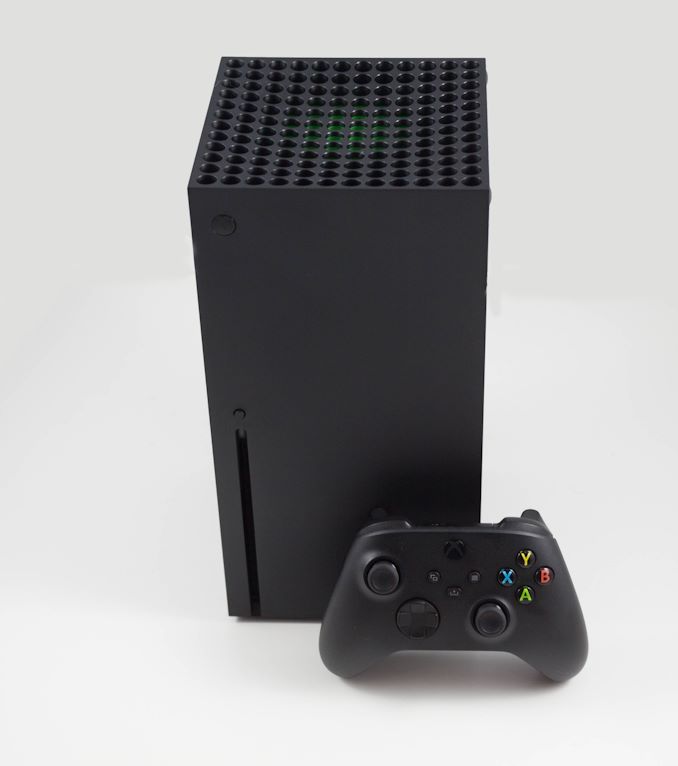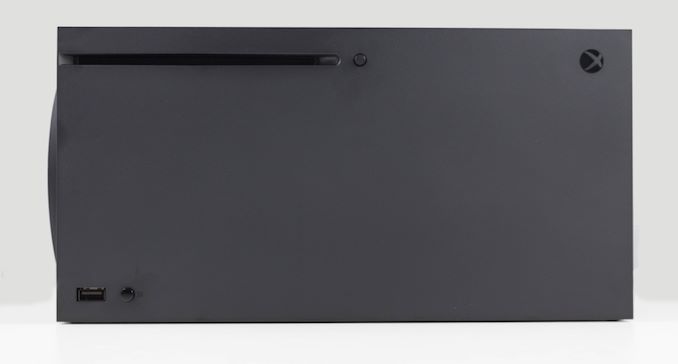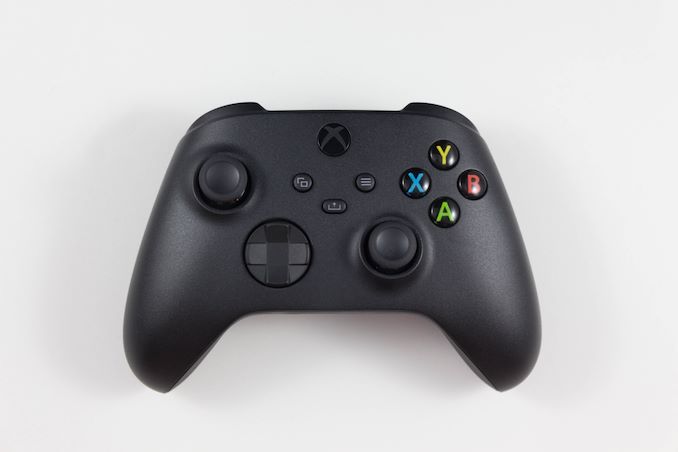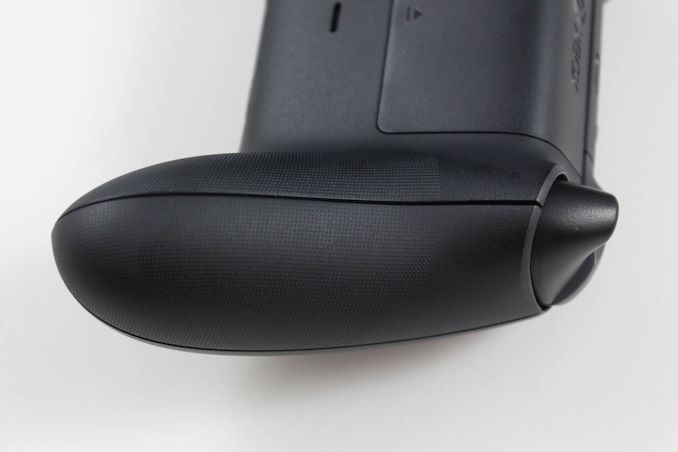The Xbox Series X Review: Ushering In The Next Generation of Game Consoles
by Brett Howse on November 5, 2020 9:00 AM ESTThe Xbox Series X Design
Now that we have gone over what is inside, let us chat about what is happening on the outside. This current next-gen console launches brought about designs which are quite different than those before. Microsoft’s Xbox Series S does offer a more traditional console look to it, but the Xbox Series X, in its all matte black finish, is decidedly untraditional.
First, the Xbox Series X is designed to ideally be placed upright, as in standing vertically. Now, to be sure, there are rubber feet which allow the console to sit horizontally, however there are small tells that this isn't Microsoft's preferred position, and as such the console looks a bit odd on its side. The Xbox icon on the power button would be rotated if placed on its side, much like the Xbox Series S power button is designed for a horizontal arrangement. The Series X dimensions feel a bit off when the console is laid horizontally, with it being quite tall, but very shallow looking. There is no one saying it won’t work on its side, and Microsoft including rubber feet on the console means that they also have no issues with it being kept horizontally, but from a pure aesthetics view, it looks a bit more proper when standing up.
That is a shame for anyone that wants to place the Xbox in a rack of electronics. The matte black finish works well in this scenario since it would match other AV equipment, but most AV shelves are not designed for the vertical Xbox, so you would have to put it on its side, and be forced to face the cringe-worthy look of the sideways power button for years to come.
The main reason for the square vertical design is of course heat. The Xbox Series X is the most powerful console built to date. It's also one of the most power-hungry. Despite the use of 7 nm TSMC transistors, packing 12 TFLOPS of GPU along with 16 GB of GDDR6 and an 8-core Zen 2 processor means that there is a significant amount of thermals to deal with. We will go into how well it handles the thermal requirements shortly, but clearly the design team wanted a console that was first and foremost cool and quiet, so they've designed around that.
The aesthetics are very subdued, with not a lot of defining features of the design when looking from the front, other than the slot-loading UHD Blu-Ray drive. The power button is on the left, and lights up in use, but there are no flashy lights otherwise.
As much as it may seem silly to RGB all the things, it might have been nice to see some Xbox green LEDs to give a soft glow out of the top of the unit, with the option to disable them, because otherwise there is not a lot to see. The top of the unit does feature a wide grille for hot air to escape, and it does feature some subtle green coloring, but that coloring can not be seen in a dark room.
The matte finish looks great, but be warned: it is a fingerprint magnet.
The sides of the Series X are completely devoid of anything. The rear does have a bit more venting for air intake, along with the bottom which also features a podium to raise the unit slightly, and of course on the back are the main AV connectors, Ethernet, USB Type-A, and the storage expansion slot.
Xbox Series X Controller – Subtly updated
For this generation, Sony has significantly updated their controller, but Microsoft took the safer approach. Microsoft’s Xbox team seems very serious about blurring the generational lines, and introducing a new controller, especially when the existing one was so well received, may have alienated some fans. Also, it means all Xbox One controllers will work with the new system, which is great as people may have purchased custom controllers, or one of the Elite controllers.
The new controller features the standard Xbox Wi-Fi Direct connection that has been around since Xbox One, although with Dynamic Latency Input, which polls the controller more often for reduced lag. Microsoft added Bluetooth support to the Xbox One controller as a mid-cycle refresh, and for the new generation they are expanding that to include Bluetooth Low Energy, meaning it will be compatible with more devices, and be easier to pair.
Physically, all the changes to the controller are very subtle. The most noticeable change is that there is now a new share button located right in the middle of the controller. When Xbox One launched, sharing was expected to be done via Kinect, but as that system died a painful death, it was replaced by being able to share by pressing the Xbox button, then sharing. It was a somewhat painful process. The new share button allows for screenshots by tapping the button, or video clips by holding the button.
The controller continues to utilize AA batteries, and Microsoft is all-too-happy to sell a rechargeable kit as an optional accessory. The controller now can charge via USB Type-C, which is great to see, as most phones have made the switch as well, so having a Type-C charger handy is not that unlikely. If you were someone who purchased the Chatpad, it is also still possible to use on the new controller, which like the previous generation, also has a 3.5 mm audio jack on the bottom for a headset connection.
The controller finish has also been tweaked, with a slight texture on the controller arms now, providing less of a chance of the controller slipping when hands get sweaty. The same texture is also on the triggers.
The D-pad has also been overhauled, moving from having just the cross, to now being a full circle with a raised cross, which should help tremendously on games that expect you to press in the midpoints.
The new controller feels great with the new textures, but most definitely is not a departure from the Xbox One controller in most respects. This was not an accident, since the Xbox One controller was quite good, and with the heavy emphasis on backwards compatibility, keeping the same basic controller design makes a lot of sense. That being said, it does not feel next gen because it is more or less the same as the previous design.
If you were a fan of the Xbox Design lab, where you could design a custom controller, it is currently not available as they ramp up for the new controller, so look for it to be back in 2021.














68 Comments
View All Comments
marees - Saturday, November 7, 2020 - link
I would need 3 things to buy this console:1. Releasing Flight Simulator for console
2. Allowing to install xcloud app on console
3. A more universal release of All Access plans (for all countries)
Basically I would like to play the Flight Simulator without having to install it (or a huge download)
cmdrdredd - Monday, November 9, 2020 - link
Sony is doing a pretty terrible job with the PS5 so I don't know where you get that idea from. They botched the pre-order launch, hid a lot of details about backwards compatibility, don't support VRR at launch, and have a weaker system overall. It'll sell out because of the popularity of the brand alone but the Series X is the top console this time around.FunBunny2 - Thursday, November 5, 2020 - link
sure looks like a Mac Trashcan. I expect MS hopes this thing works out better.vailr - Friday, November 6, 2020 - link
How difficult will it be to install an alternative operating system on the X-Box Series X? It seems to be compatible with running either macOS or Windows, if the bios firmware can be altered sufficiently to allow booting into another O.S.. Interesting to see what happens.tkSteveFOX - Friday, November 6, 2020 - link
I really don't see the point of having an 8/16 CPU in the S. Why didn't they cut it to 6/12 to save some space/thermals?That GPU in there is totally a bottleneck for the CPU.
I'm sure fans would have wanted a slightly better GPU in favour of the 8 core CPU with 16 threads.
I just find it illogical as a choice.
Brett Howse - Friday, November 6, 2020 - link
If they drop that too far, games that have the same visual elements (think a busy city street with a lot of NPCs) might not be possible on the Series S which would mean that the developer would just target the lowest common denominator. It makes a lot of sense why they have kept the CPU similar.jabber - Friday, November 6, 2020 - link
Also might be some 'currently locked' potential they can free up at a later date as a bonus.eastcoast_pete - Friday, November 6, 2020 - link
Also, I would be amazed if MS doesn't use the Series S to "reduce, reuse, recycle" the APUs that didn't make the cut for the Series X, but work okay at lower speed. There are several "bins" before the one labeled "garbage".eastcoast_pete - Friday, November 6, 2020 - link
Looking again at the specs, that "recycle" might also apply to the GDDR6 in the series S. That memory bandwidth really gimps the S; I think that was a mistake, with a slightly wider bus and even half the bandwidth of the Series X, it could have been a contender (yes, that old Rocky quote).FunBunny2 - Saturday, November 7, 2020 - link
"yes, that old Rocky quote"young-un!!!
"I coulda' had class. I coulda' been a contender. I coulda' been somebody. Instead of a bum, which is what I am."
-- Terry Malloy/Marlon Brando 'On The Waterfront' 1954